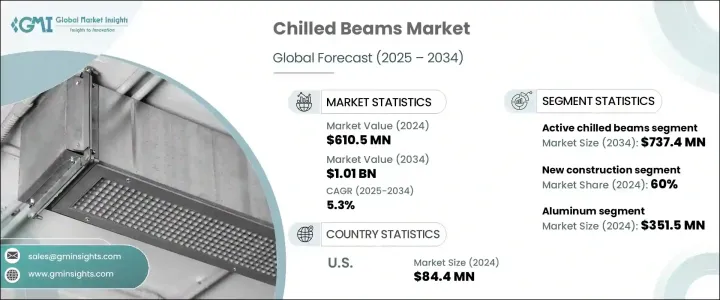
세계의 칠드빔 시장은 2024년 6억 1,050만 달러로 평가되었고, 지속가능한 건설과 에너지 절약 기술에 대한 세계적인 주목이 증가함에 따라 CAGR 5.3%로 성장할 전망이며, 2034년에는 10억 1,000만 달러에 이를 것으로 예측됩니다.
에너지 규제가 엄격해지고 이산화탄소 삭감에 대한 의식이 높아짐에 따라 칠드 빔 시스템은 고효율과 환경 친화적인 성능으로 인기를 끌고 있습니다. 이러한 시스템은 현대 냉난방 인프라에 필수적인 것으로 인식되고 있습니다. 물을 열교환의 매개체로 이용함으로써 칠드빔은 에너지 소비를 크게 줄이면서 정확한 온도 제어를 제공합니다. 실내 공기의 질을 개선하고 운영 비용을 절감하는 그 능력은 차세대 HVAC 솔루션에서 그 역할을 더욱 확고히 하고 있습니다.

시장은 지속 가능한 건물을 뒷받침하고 있으며 정부의 의무화 및 그린 건설에 대한 인센티브에 의해 강화되고 있습니다. 또한 세련되고 효율적이며 커스터마이징 가능한 HVAC 설계를 선호하는 건축 동향도 수요를 끌어올리고 있습니다. 에너지 효율이 신축 프로젝트의 핵심을 차지하는 가운데, 칠드빔은 그 신뢰성과 환경면에서의 우위성 때문에, 선호되는 솔루션이 되고 있습니다. 또한 이러한 시스템을 통해 건축가는 HVAC 기능을 건물의 미관에 통합할 수 있어 쾌적함과 시각적 매력 모두에 기여하는 원활한 디자인을 만들어 낼 수 있습니다.
| 시장 범위 | |
|---|---|
| 시작 연도 | 2024년 |
| 예측 연도 | 2025-2034년 |
| 시작 금액 | 6억 1,050만 달러 |
| 예측 금액 | 10억 1,000만 달러 |
| CAGR | 5.3% |
액티브 칠드빔은 2024년 시장 가치로 4억 3,850만 달러를 차지했으며, 2034년에는 7억 3,740만 달러에 이를 것으로 예측됩니다. 이러한 시스템은 뛰어난 온도 조절 기능과 고성능 공기 품질을 지원하는 능력으로 인해 점점 더 지지받고 있습니다. 패시브 시스템과 달리 액티브 칠드빔은 공기 유도를 포함하고 있어 더 큰 기류와 정밀한 제어를 제공합니다. 그린 빌딩 인증에 대응하고 장기적인 에너지 비용을 절감하기 위해 많은 상업 시설과 시설에서 선호되고 있습니다.
2024년 신축 빌딩의 점유율은 60%로 도시화가 확대되고 지속가능한 개발이 표준화됨에 따라 칠드빔은 에너지 효율적인 설계에 근본적으로 통합되어 왔습니다. 건설업자나 개발업자는, 쾌적성과 비용 삭감을 실현하면서 환경 목표를 채우는 그린 HVAC 시스템을 우선하고 있습니다.
미국의 칠드빔 시장은 2024년에 8,440만 달러에 달했습니다. 주택 및 상업 인프라 프로젝트의 기반이 견고하고, 왕성한 수요를 지지합니다. 에너지 절약 정책이나 도시 개발의 급성장과 함께, 지속가능성이 중시되어 기존의 HVAC를 대체하는 에너지 효율이 높은 칠드빔 시스템이 널리 채용되고 있습니다.
시장 포지션을 강화하기 위해 Halton Group, Swegon AB, Barcol Air Group AG, Johnson Controls International Plc, Dandanco Europe, Roccheggiani SpA와 같은 기업들은 제품 혁신과 전략적 확장을 결합하여 구현하고 있습니다. 연구 개발에 투자하여 에너지 성능과 미관의 유연성을 실현하고 진화하는 건축 수요에 대응하는 시스템을 개발하고 있으며, 개발자와 HVAC 컨설턴트와의 공동 개발을 통해 특정 지역의 요구에 맞는 제품을 제공합니다.
The Global Chilled Beams Market was valued at USD 610.5 million in 2024 and is estimated to grow at a CAGR of 5.3% to reach USD 1.01 billion by 2034, driven by a rising global focus on sustainable construction and energy-saving technologies. As energy regulations become more stringent and awareness around carbon reduction increases, chilled beam systems are gaining popularity for their high efficiency and eco-friendly performance. These systems are now recognized as essential in modern heating and cooling infrastructure. By utilizing water as a medium for heat exchange, chilled beams offer precise temperature control while significantly reducing energy consumption. Their ability to improve indoor air quality and reduce operational costs has further solidified their role in next-generation HVAC solutions.

The market pushes for sustainable buildings, reinforced by government mandates and green construction incentives. Demand is also being boosted by architectural trends that favor sleek, efficient, and customizable HVAC designs. With energy efficiency being a core aspect of new construction projects, chilled beams have become a preferred solution due to their reliability and environmental advantages. Additionally, these systems allow architects to integrate HVAC functionality into building aesthetics, creating seamless designs that contribute to both comfort and visual appeal.
| Market Scope | |
|---|---|
| Start Year | 2024 |
| Forecast Year | 2025-2034 |
| Start Value | $610.5 Million |
| Forecast Value | $1.01 Billion |
| CAGR | 5.3% |
Active chilled beams accounted for USD 438.5 million in market value in 2024 and are expected to reach USD 737.4 million by 2034. These systems are increasingly favored for their superior temperature regulation and the ability to support high-performance air quality. Unlike passive systems, active chilled beams incorporate air induction, providing greater airflow and precise control. They support green building certifications and reduce long-term energy costs, which makes them a preferred option in many commercial and institutional settings.
New building construction represented a 60% share in 2024. As urbanization expands and sustainable development becomes standard practice, chilled beams are being incorporated from the ground up in energy-efficient designs. Builders and developers prioritize green HVAC systems that meet environmental targets while delivering comfort and cost savings.
United States Chilled Beams Market with USD 84.4 million in 2024. The country's strong base of residential and commercial infrastructure projects supports robust demand. The focus on sustainability, combined with energy conservation policies and rapid growth in urban development, has fueled widespread adoption of chilled beam systems as an energy-efficient alternative to traditional HVAC setups.
To enhance their market position, companies such as Halton Group, Swegon AB, Barcol Air Group AG, Johnson Controls International Plc, Dadanco Europe, and Roccheggiani S.p.A are implementing a mix of product innovation and strategic expansion. Key strategies include offering modular and customizable solutions, integrating smart building features, and expanding global distribution networks. Many invest in R&D to develop systems that deliver energy performance and aesthetic flexibility, aligning with evolving architectural demands. Collaborations with developers and HVAC consultants further help them tailor offerings to specific regional needs.